I love to experiment with alternative tools and techniques in my painting practice, igniting the creative process. Using alternative tools, you can introduce unique markmaking into the pictorial environment. Hair combs, wok brushes, toothpicks, sticks, sponges and eyedroppers are just some of the tools I used to create an engaging tactile color field in which to pull out my subject. By making slight alterations to my working ground, I dramatically change the look of the work. The Phoenix Rises is a mixed-media painting that I recently did using a plethora of mediums, tools and approaches. It is about the phoenix rising from the ashes to bring about a rebirth of hope.
Onto a gesso-primed Masonite working ground, I created a base texture from which to pull out my subject. Gel medium, molding paste and gesso were applied with a palette knife and debossed with various imprinting tools to create a tactile surface. Palette knife painting can build up the surface in a sculptural way. By debossing into the surface that has a layer of wet gel or molding paste applied on top, you can create an engaging bas-relief working ground. To bring out the texture and set a tone for the piece, I applied an overall wash. Using a dry brush technique, I applied heavy-body green gold paint, which I custom mixed using acrylics and iridescent medium. This helped to create the glowing embers on top of the headpiece in The Phoenix Rises. I used a green tinted metallic as a complementary color to the reds and pinks used in the dress and headpiece.
While it was still wet on the surface, I took a wide-tooth comb and scratched through the surface of the wet paint. When that was dry, I applied heavy red gesso with a palette knife, scratching into the grooves created by the combing technique of the heavy-body green gold paint. Sgraffito techniques can add interesting details to the surface of the painting. Using a fork, comb, bamboo pen or sharpening a stick, you can scratch into wet paint to reveal the ground color, creating intriguing linear detail. To add another textural layer to the work, I used a bamboo wok brush. The irregular shaped bristles add a unique imprint onto the painted surface.
Using an eyedropper, I allowed fluid acrylic black paint to drip down from the top. I used a spray bottle to disperse the paint while it was coming down, allowing the paint to fall into certain nooks and crannies that were created by the combing. The resulting look was the understructure for the headpiece of my figurative subject. To also added to the atmospheric effect I was looking for in the headpiece area. To tone down the dripping in the facial area, I painted a warm neutral throughout.
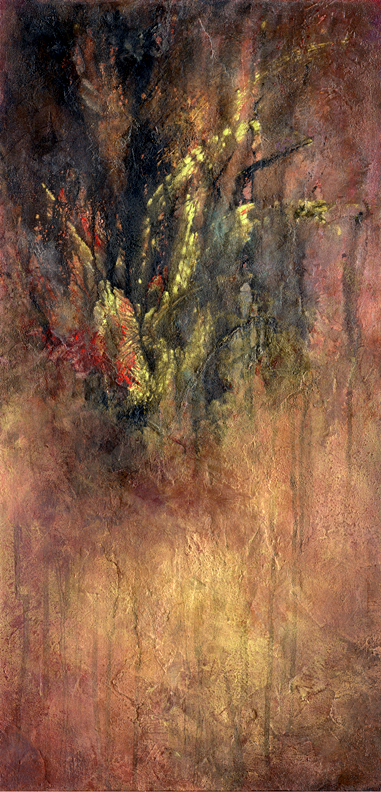
A warm neutral tone was applied in acrylics throughout the piece to establish a place for the figurative element.
Once my tactile, texture-infused color field was in place, I began to look for the best placement to add an expressive female face into the abstract composition. Onto the acrylic painted background, I used acrylic gesso and a sponge in the area where the face would evolve. To make the surface where the face would belong more even, I sanded it down using sandpaper. For some of the heavier areas, I used an electronic nail file. The application of molding paste in areas allowed me to fill in some of the tiny nooks and crannies that may be unwanted in a facial area.
The female portrait was laid in with graphite. Pencils, powdered graphite, brushes and blending stomps were used to apply the media to the surface. A kneaded eraser as well as a sharpened stick eraser were employed to creatively push, pull and remove the graphite. To seal the drawing, I used acrylic matte medium mixed with water at a 50-50 ratio. I used my daughter as a lighting reference, changing her features slightly to serve the direction I was heading with the piece. For me, my creative daughter and the younger generation are the hope of the future. They are the phoenix that rises from the ashes.
My daughter was born in NYC during a time of great upheaval. The day I was scheduled to hear her heartbeat in the womb for the first time was Sept 12, the day after the tragic events of 9/11. I watched the towers come down from the water’s edge, as we lived across the World Trade Center on the Jersey side. I was pregnant, scared and worried because my husband was downtown at the time. This, for me, was the ashes.
Years later, my daughter Michaela Short would graduate from high school in 2020, the year that was slated for perfect vision. Prom, award ceremonies, graduation and all that comes with this special time in life was canceled and put on hold because of the Covid-19 global pandemic. During this time, my daughter dug into her creative work, her superpower was rising. Taking her college classes on Zoom, heading up a club, attending events online and continuing to create were her source of strength. She won many prestigious regional and national student production awards presented by the National Academy of Television Arts and Sciences for her student film and audio work, yet, was never able to attend a single red carpet event. Amidst the burning embers, she pushed through, rising from the ashes. “As a filmmaker, I want to bring the beauty of imagination to life, inspiring others to look within to see light in a world often filled with darkness,” shares the aspiring filmmaker. “Telling stories through the power of film, creates a robust platform for delivering messages of hope, joy and love, sparking positive change in the hearts and minds of others.” It is the resilience, strength and courage of conviction of this generation that I feel so hopeful for the future.
Here is her film trailer for The Beauty of Believing: Dark Shadows. THE NATIONAL ACADEMY OF TELEVISION ARTS & SCIENCES COLLEGE/UNIVERSITY STUDENT PRODUCTION AWARDS CINEMATOGRAPHY- Winner First Place, AUDIO/SOUND – Winner First Place and EDITING – Honorable Mention
My daughter (college sophomore) just won FIVE First Place New England Student Production Awards: Cinematography, Animation/Special Effects, Audio, Talent/Performance and Music Video! She also won TWO Honorable Mentions for Director and Editing! Check out her award-winning VIDEO on YouTube below called ASHES…about her love and passion for dragons!
You can see more of my daughter’s film, audio, photo and illustration work here. She is only a Sophomore in college!
By cutting down the bristles of some of my worn brushes, I can scrub the graphite into textural surfaces. Soft brushes work great for smoother surfaces.Over the drawing, I used acrylics to do a color block-in. Painting in acrylics and the matte medium mixture, I was able to boldly lay in the picture in regards to the facial component. The color lay-in helped me to see where I want to go with the picture in terms of mood.
To establish the decorative headpiece, I started by sketching out an overall dynamic gesture and flow that would fit the already existing composition. From there, I started designing elements that would convey aspects of a phoenix. Lots of complex swirls, peacock feather-like designs, dragon elements and the like were sketched and then translated into relief. Using gel medium, molding paste, self-leveling clear gel and matte medium, I started to build up a dimensional headpiece. Using custom-designed stencils that I create and cut with a die-cutting machine, pastry bag with various applicator tips and molds, I created the headpiece in layers. Textures are established onto the raised graphic areas using debossing techniques, where I press into the top layer to create a subtle texture. I also remove wet gel or molding paste with a with a sharpened stick when it is still wet or Dremmel tool with different applicators if it is dry. Acrylic paint and matte medium help to unite the various mediums and surface textures. Self leveling clear gel is used to create very fine details.
I work on a flat surface to do this type of work, allowing areas to dry in stages. This process takes a ton of patience, focus and an understanding that every layer needs a support layer underneath. I work on multiple projects at once, giving the work time to fully cure between layers.
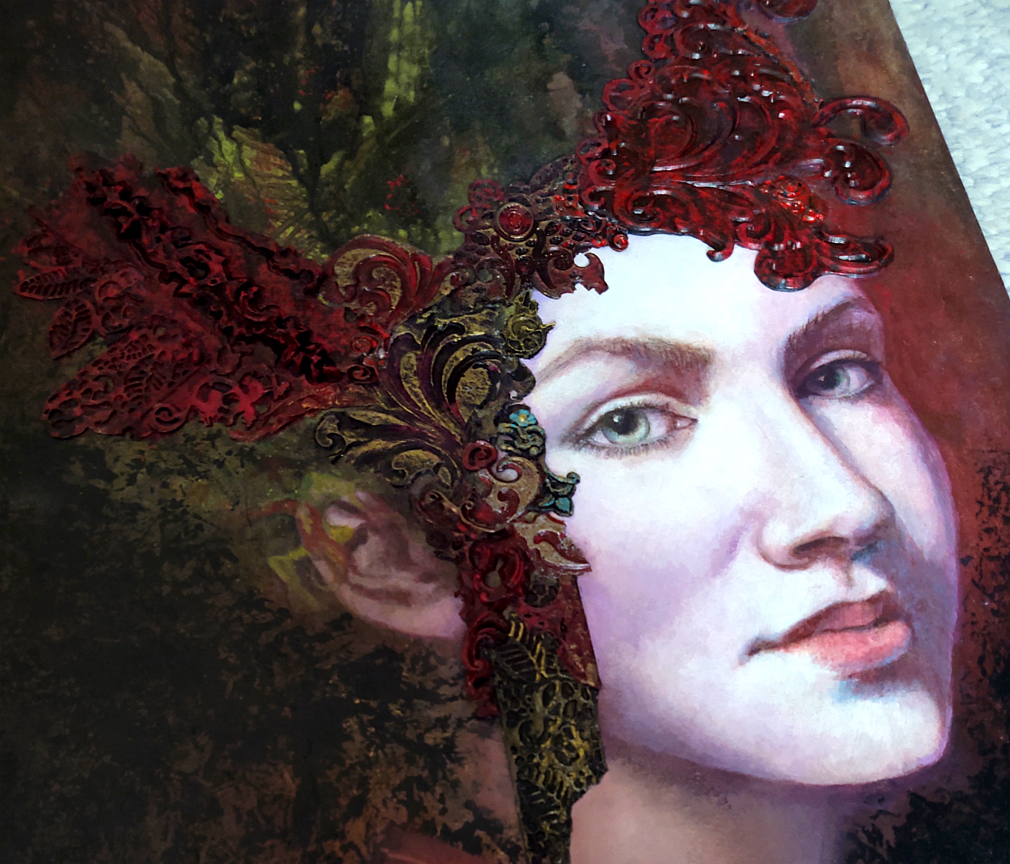
The Face is blocked-in with acrylics. At this stage, Quinacridone Red Orange, Dioxazine Violet, Cadmium Red Deep, Alizarin Crimson, Burnt Umber, Burnt Sienna, Ivory Black, Gold and acrylic gesso (for the whites) are used for both the face and the head piece.

After the dress was blocked-in in acrylics, white conte pencil was used to temporarily draw in where the embroidered details of the phoenix would be painted. The face is still in the acrylic block-in stage.
For the dress, I blocked-in the general color patterns in acrylics. To add the stitched details, I sketched in the patterns in white conte pencil. I then carefully painted in the embroidery in color. Since the understructure was textural, it gave an interesting effect on the areas that were more solid, creating the illusion of another pattern in the red areas of the dress.

The dress and face are fully blocked-in with acrylics. The next step is to render the piece further using oils.
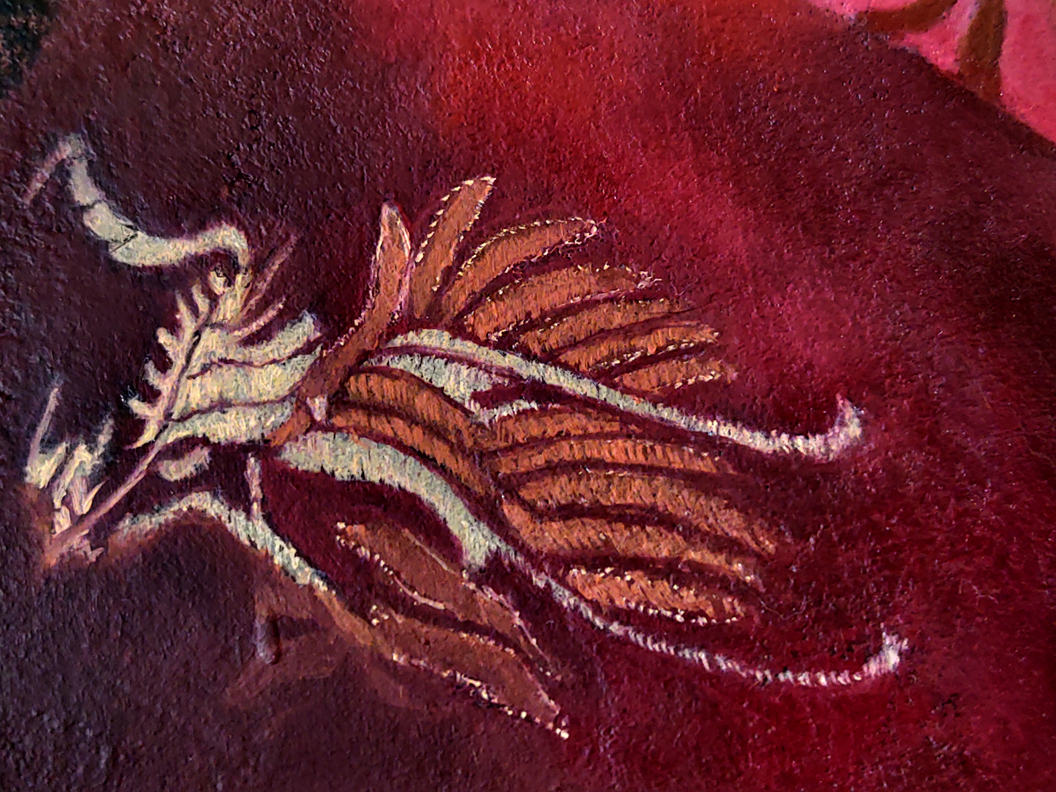
Using a toothpick, I can apply dots as well as scratch-back and drag paint to look like stitching. The above picture is a extreme close-up. When you step back from the painting the detail has the feel of embroidery.
Once the dress was blocked-in in acrylics, I switched to oil paint to fine-tune the details. With the overall color palette established, I went into the face and reworked it in oils as well. I also starting glazing areas of the background to bring the face forward and lose edges in the headpiece. The painting stages are done on my easel. You can see my custom mahl stick on the right in black.
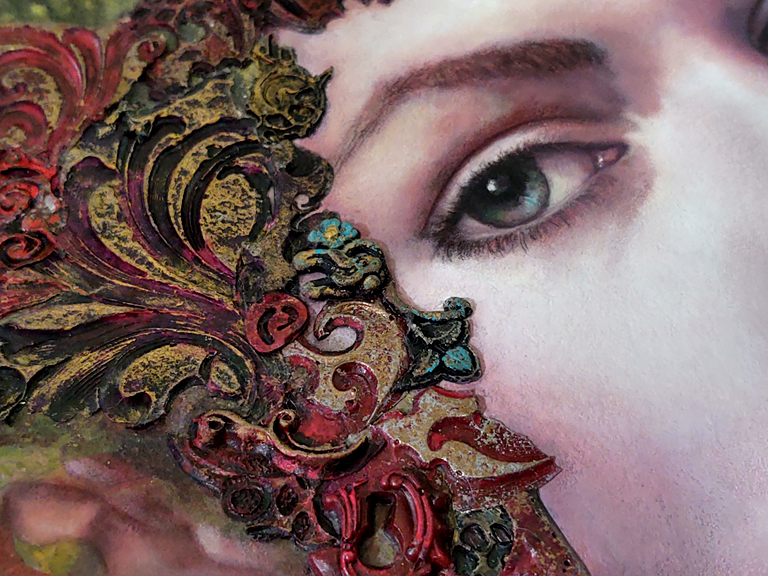
Close up of bas-relief details with acrylic patinas added. The face is now in the first-coat stage of oil painting. In addition to the abstract shapes pulled from the phoenix design concept, I added some floral elements near the face. This was to convey the story that the phoenix rises from the ashes and a rebirth of hope is coming. I made them blue to match the eyes, the window of the soul.
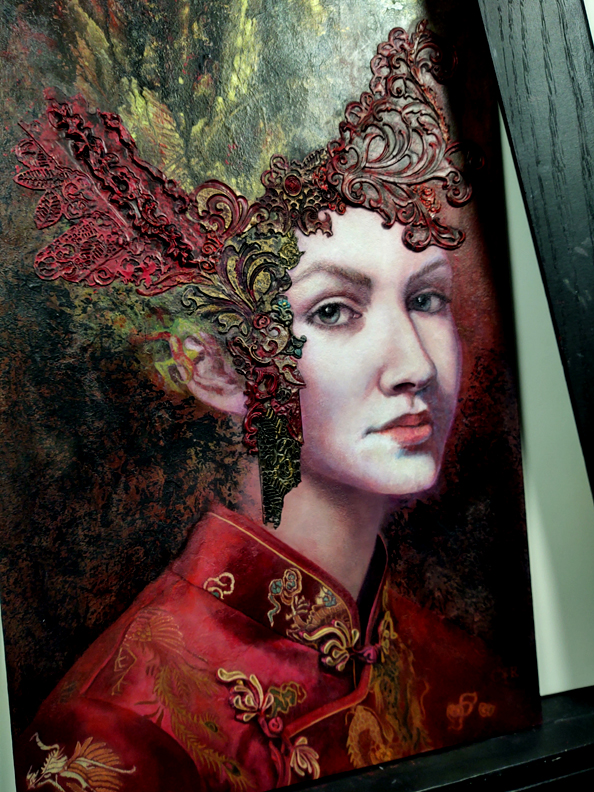
At this stage, both the dress and the face have been painted with a first coat using oils, further refining the piece. One more final coat is left to finalize the piece!



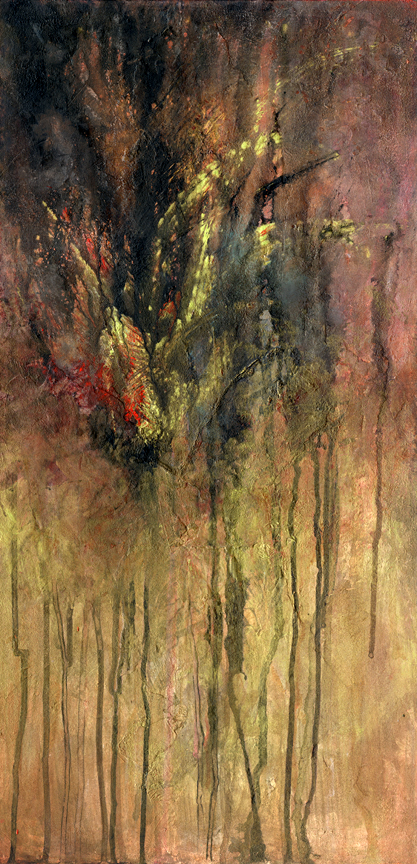

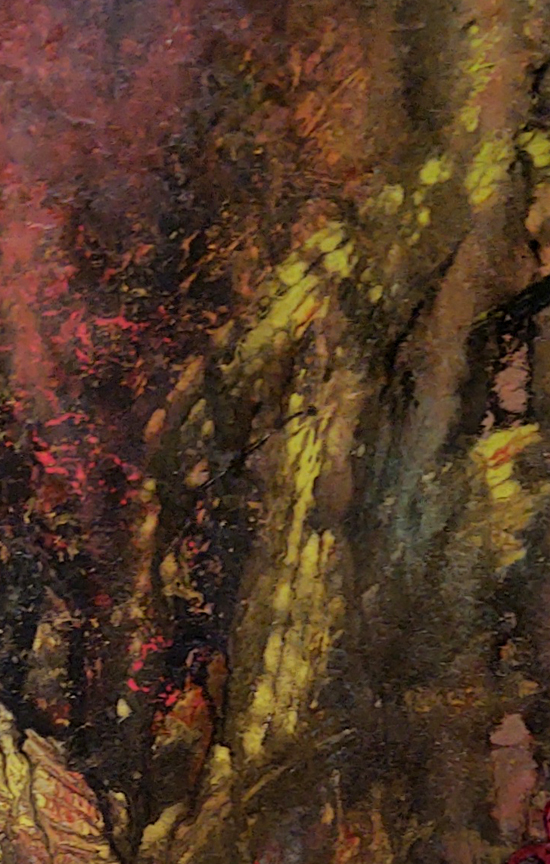


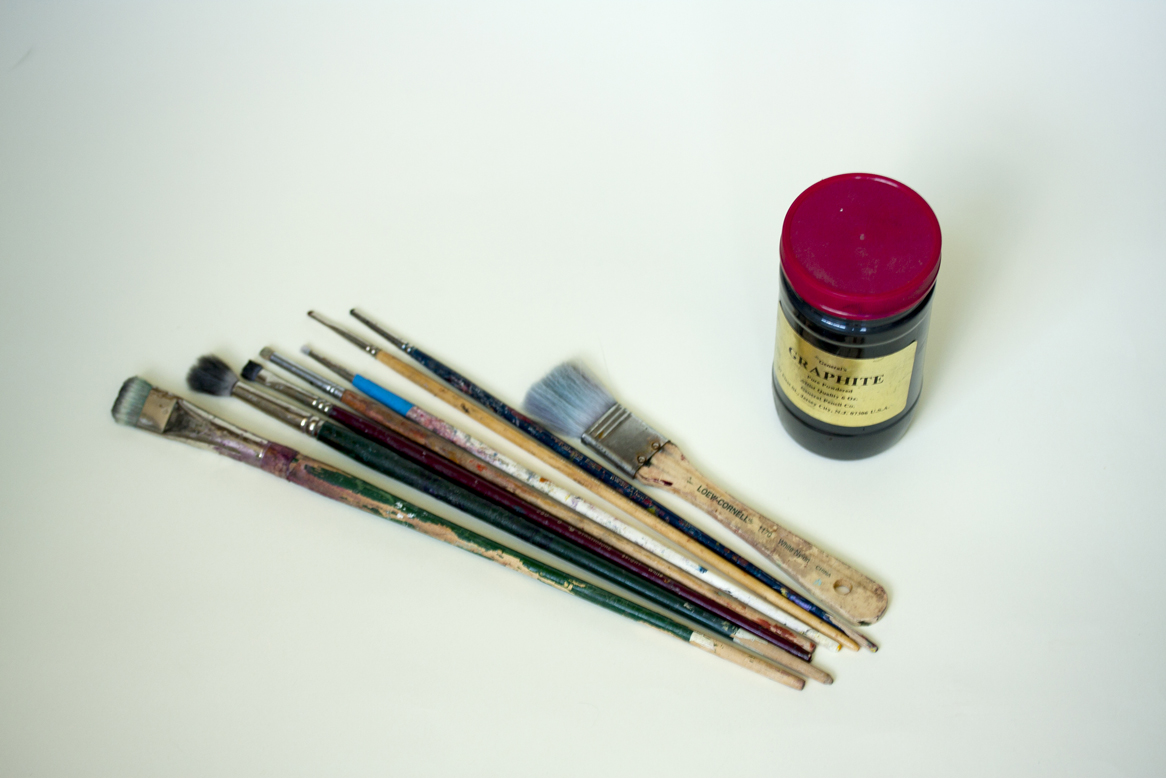

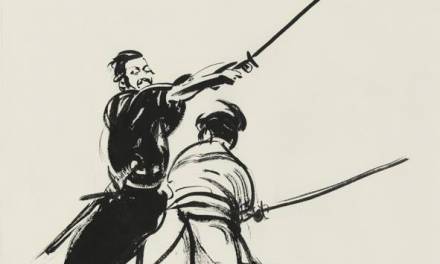
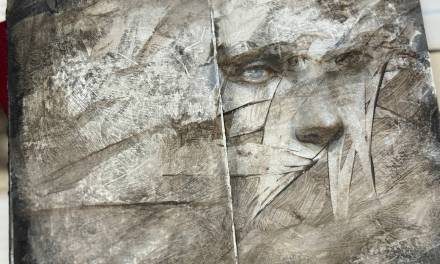
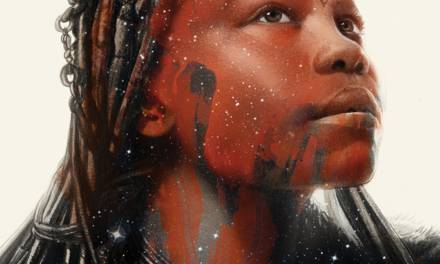

Excellent article Lisa, I love using various tools to achieve fascinating textures into my paintings as well. Not only is it fun but it keeps you on your creative toes as you can conjure up something that’s even better than what you were thinking of! 🙂
Thanks so much Brian! I completely agree!
Great minds think alike! 😉